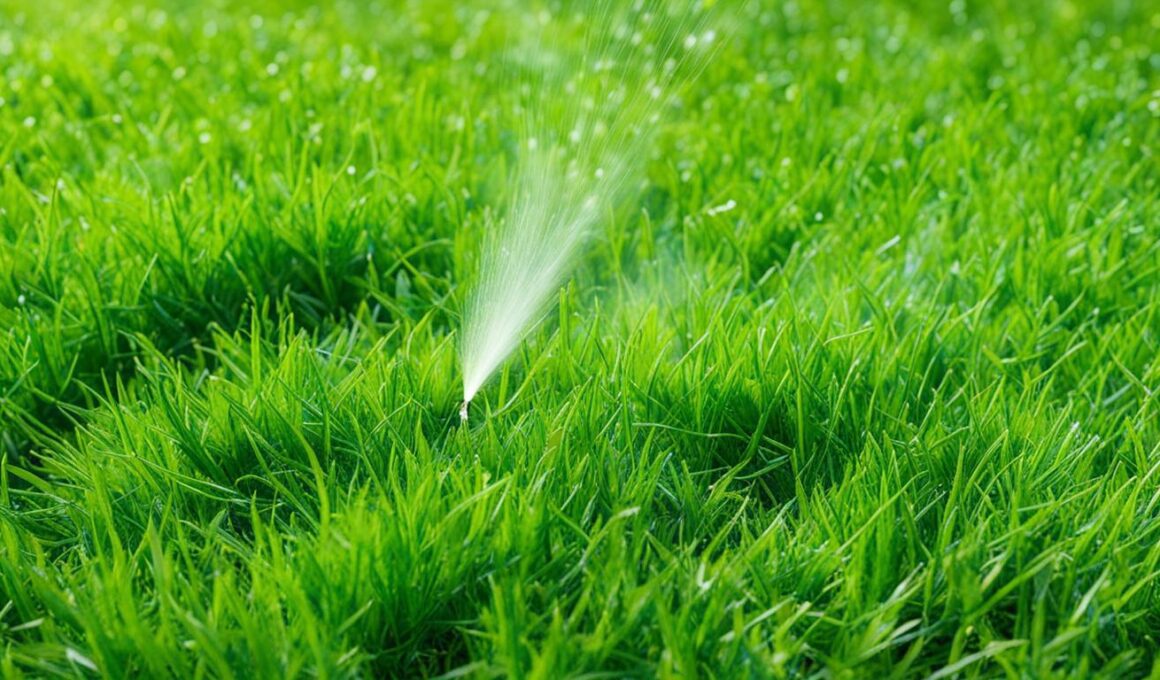Welcome to our guide on how to achieve a lush and weed-free yard through effective post-emergent weed control. Maintaining a healthy lawn is the dream of every homeowner, and post-emergent weed control plays a vital role in making that dream a reality.
Nothing disrupts the beauty and uniformity of your lawn quite like weeds. Not only can they ruin the visual appeal, but they also compete with your desired grass for water, nutrients, and sunlight. If left unchecked, these pesky intruders can quickly take over your yard, leaving you with a dull and patchy lawn.
But fear not! With the right approach and the use of appropriate herbicides, you can take control of those weeds and transform your lawn into a lush oasis. Say goodbye to unsightly dandelions, nutsedge, Poa Annua, and other common post-emergent weeds that plague lawns across the United States.
In this comprehensive guide, we will walk you through the process of understanding post-emergent weed control, identifying common post-emergent weeds, selecting the right herbicides, and applying them effectively. By the end, you’ll be equipped with the knowledge and tools to achieve the weed-free yard of your dreams.
So, let’s dive in and discover the secrets of post-emergent weed control that will elevate your lawn to a whole new level of beauty and health.
Understanding Post-Emergent Weed Control
Post-emergent weed control plays a vital role in maintaining a healthy and beautiful lawn. It involves targeting fully germinated weeds with the use of herbicides. These herbicides are designed to be absorbed by the weeds, allowing them to be translocated throughout the entire plant. As a result, post-emergent weed control effectively eliminates fully germinated weeds from your lawn.
To achieve optimal results, it is essential to select the right weed control materials. Different herbicides are formulated to target specific types of weeds, so it’s crucial to identify the weeds you are dealing with before choosing the appropriate herbicide. By using the correct post-emergent weed control materials, you can not only eliminate existing weeds but also reduce the chances of future regrowth.
Implementing post-emergent weed control in your lawn care routine will help ensure that your yard remains free from fully germinated weeds, allowing your grass to thrive and maintain its lush green appearance.
Common Post-Emergent Weeds
When it comes to post-emergent weed control, it’s essential to be familiar with some of the most common post-emergent weeds that you may encounter in your lawn. These weeds can be effectively controlled with post-emergent herbicides, provided you choose the right herbicide for each specific weed.
One common post-emergent weed is Poa Annua, which typically emerges in late summer. This annual grass weed can quickly spread and take over your lawn if left unmanaged. By using post-emergent herbicides specifically formulated for Poa Annua control, you can effectively suppress its growth and prevent it from overpowering your lawn.
Another common post-emergent weed is Nutsedge, a stubborn perennial weed that can be a challenge to control. Nutsedge is characterized by its triangular-shaped stem and clusters of three leaves that resemble grass blades. Post-emergent herbicides targeted towards Nutsedge can help eliminate this persistent weed and keep it from regrowing in your lawn.
Dandelions are yet another prevalent post-emergent weed that can be found in lawns throughout the country. These broadleaf weeds are recognizable by their yellow flowers and fluffy seed heads. Post-emergent herbicides designed to target broadleaf weeds, including Dandelions, can effectively eradicate them and prevent them from spreading.
To visually illustrate these common post-emergent weeds, take a look at the image below:
By familiarizing yourself with these common post-emergent weeds and selecting the right herbicide for each specific weed, you can effectively control their growth and maintain a beautiful, weed-free lawn.
The Importance of Selecting the Right Post-Emergent Herbicides
When it comes to effective weed control, choosing the right post-emergent herbicides is crucial. Not all herbicides are created equal, and selecting the appropriate product for your specific needs can make all the difference in achieving a weed-free lawn. But how do you know which herbicide is right for you?
First and foremost, it’s essential to read and follow the label instructions carefully. The label provides crucial information about the product, including which weeds it targets and how to apply it safely. By understanding the label instructions, you can ensure that you’re using the herbicide correctly and maximizing its effectiveness.
One critical factor to consider is selectivity. Some post-emergent herbicides are selective, meaning they target specific types of weeds without harming desirable plants. These products are ideal if you have a lawn abundant with turfgrass or other desirable vegetation. On the other hand, non-selective herbicides can harm a wide range of plants, so exercise caution when applying them to avoid damage to your lawn or garden.
Additionally, take note of any restrictions mentioned on the label. Some post-emergent herbicides have specific requirements for grass types, temperature, or irrigation during application. To achieve optimal results, carefully adhere to these guidelines. Ignoring these restrictions may lead to less effective weed control or unintended damage to your lawn.
By selecting the right post-emergent herbicides and following label instructions, you can effectively control weeds without any negative consequences. Achieving a lush and weed-free yard is within reach when armed with the right products and knowledge.
Factors to Consider Before Purchasing Post-Emergent Weedkiller
When it comes to tackling those pesky weeds in your lawn, choosing the right post-emergent weedkiller is crucial. Before making a purchase, there are a few key factors to consider.
Identify the Types of Weeds You Need to Target
First and foremost, it’s important to identify the types of weeds you need to target. Are they broadleaf weeds, grassy weeds, or perhaps sedge and aquatic weeds? Different herbicides are formulated to target specific weed types, so understanding the specific weeds in your lawn will help you choose the most effective solution.
Consider the Selectivity of the Herbicide
The selectivity of the herbicide is another important factor to consider. Selectivity refers to the herbicide’s ability to target the weeds without harming desirable plants. Some post-emergent weedkillers are selective, meaning they only target specific weed types, while others are non-selective, meaning they can harm a wide range of plants. Consider the plants you want to protect and choose a weedkiller accordingly to minimize any unintended damage.
Assess the Environmental Impact
Considering the environmental impact of the weedkiller is crucial for maintaining a healthy and sustainable lawn. Look for information about the herbicide’s persistence in the soil and its potential effects on beneficial insects and wildlife. Opt for weedkillers with low environmental impact to ensure the long-term health of your lawn ecosystem.
By taking these factors into account, you can make an informed decision when purchasing a post-emergent weedkiller. Remember, knowing the types of weeds, understanding selectivity, and considering the environmental impact are key to achieving effective weed control without any negative consequences.
Types of Post-Emergent Herbicides and Their Uses
When it comes to post-emergent herbicides, there are different types available that target weeds in various ways. Understanding these different types can help you choose the most effective option for your weed control needs.
Contact Herbicides: Contact herbicides are designed to work upon direct contact with the foliage of the targeted plants. They provide quick results by rapidly affecting the weed’s cells and causing damage. Contact herbicides are beneficial for eliminating visible weeds above the ground, but they may not fully eradicate the root system.
Systemic Herbicides: Systemic herbicides, on the other hand, are absorbed by the plant and translocated to the roots. This means they have the ability to travel throughout the entire plant, providing longer-lasting control. As systemic herbicides target the root system, they can effectively eliminate the entire weed, preventing regrowth.
Residual Herbicides: Residual herbicides have a different approach to weed control. These herbicides remain active in the soil, creating a barrier that prevents weed seeds from germinating or newly emerging weeds from establishing themselves. They can provide long-term control, making them ideal for preventing weed growth before it becomes a problem.
Each type of post-emergent herbicide has its own benefits and considerations. Contact herbicides offer quick results, systemic herbicides provide longer-lasting control, and residual herbicides prevent future weed growth. The choice will depend on the situation, the specific weed problem, and the level of control you desire.
For a better understanding, refer to the following image:
Application Methods for Post-Emergent Herbicides
The effectiveness of post-emergent herbicides greatly depends on the application method. There are various options to choose from, including sprays, granules, and spot treatments. Each method has its advantages and is suitable for different situations.
Sprays
Sprays are one of the most common and convenient ways to apply post-emergent herbicides. They come in ready-to-use or concentrated formulations. Ready-to-use sprays are pre-mixed and ready to be sprayed directly onto the target weeds. Concentrated sprays require dilution before application, allowing you to customize the concentration based on your specific needs. Sprays provide good coverage and are ideal for small to medium-sized areas.
Granules
If you have a larger area to treat, using granules may be a more practical option. Granules are applied with a broadcast spreader, which evenly distributes the herbicide across the lawn. This method ensures uniform coverage and is efficient for controlling weeds in expansive spaces. Granules are popular for treating lawns, sports fields, and other large outdoor areas.
Spot Treatments
Spot treatments involve applying the herbicide directly to the leaves of the target weed. This method is especially useful when dealing with isolated weeds or specific areas of weed infestation. Spot treatments are precise and minimize the potential for the herbicide to come into contact with non-target plants. To apply a spot treatment, use a sprayer or a designated spot treatment applicator for accurate and controlled application.
To achieve optimal results, it is crucial to ensure proper application techniques. Regardless of the method you choose, follow the instructions provided on the herbicide label. This will guide you on the appropriate amount to apply, the recommended timing, and any specific precautions to take. Good coverage of the target weeds is essential to ensure effective control, while minimizing the risk of runoff or drift onto non-target plants.
Is Using Micro-Clover a Good Alternative to Post-Emergent Weed Control for Lawn Health?
When considering microclover for your lawn, it’s essential to weigh the microclover lawn pros and cons. While microclover can suppress weed growth and provide natural fertilization, it may not completely eradicate all weeds. Additionally, some find the appearance of clover in lawns to be a drawback.
Conclusion
Post-emergent weed control is an essential component of maintaining a healthy lawn. Understanding the types of weeds that plague your yard is the first step in effectively eliminating them. By selecting the right herbicides and following label instructions, you can achieve optimal weed control and promote a lush, vibrant lawn.
When using post-emergent herbicides, it is important to consider the environmental impact. Choose herbicides that have minimal adverse effects on beneficial insects and wildlife. Additionally, take necessary safety precautions to protect yourself, your family, and your pets during application.
With careful management and ongoing weed control efforts, you can enjoy a weed-free yard that enhances the beauty and health of your lawn. Regular maintenance, such as mowing at the proper height and ensuring adequate irrigation, will also contribute to the overall success of your weed control program.











